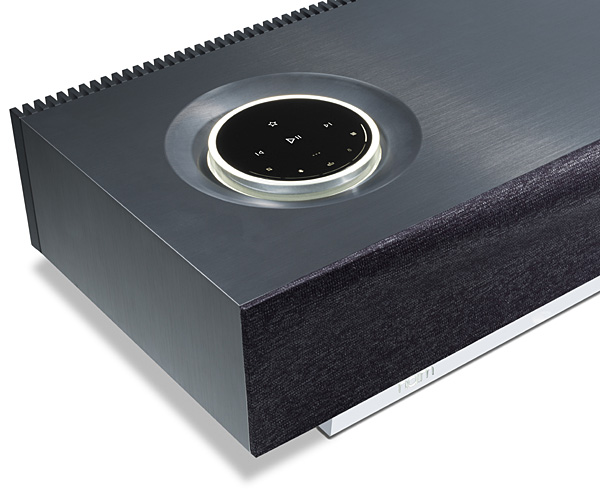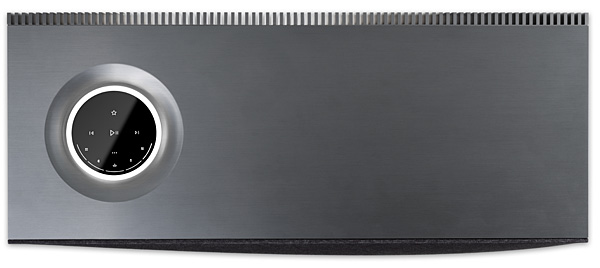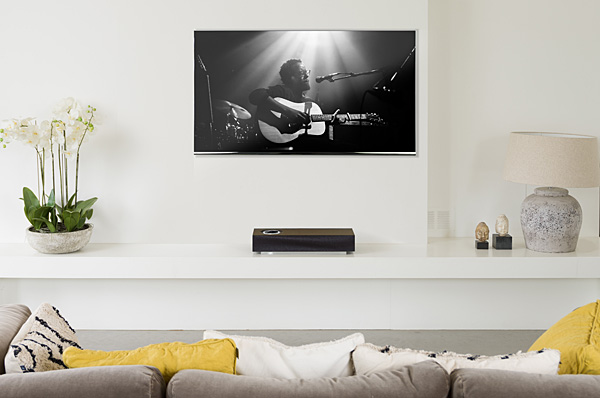Naim Audio Mu-so 2 Wireless Music System Review Page 2
Listening
I found the Mu-so 2's sound to be extremely powerful and authoritative for such a small system. Its ability to play loud and hit sudden peaks, and the subtlety with which it handled small dynamic swings lost by most compact and even full-bore audio systems, was off the charts for this class of product. This commanding persona was mixed with ultra-smooth, balanced sound and a super-clean transparency in the mids and highs that was addictive and kept me coming back for more.

On the downside, the Mu-so 2 makes two not-unexpected compromises attendant to squeezing all that audiophile goodness into a 2-foot-wide box. First, despite my attempts to optimize its imaging by tinkering with position, it just couldn't throw a terribly wide soundstage. This was true even when I positioned myself well back from the baffle, as much as 15 feet. Naim rightfully sticks with the purist approach by using discrete stereo channels and no DSP trickery to artificially blow out the soundstage, but the tradeoff is that there's only so much you can do when your left/right tweeters are 15 inches apart. Ultimately, the system filled my large room with sound and offered modest horizontal separation of instruments and vocals, but things were clearly squished together. On the other hand, the Mu-so 2 managed some depth within that truncated width, and from my normal 10-foot distance it projected centered vocalists and instruments well out from and above the front of the unit, providing a reasonably layered front-to-back presentation. This dimensionality, along with that smooth, clear sound, was the ticket to immersion.
The Mu-so 2's other weakness was its ultimately limited bass response. Naim may have made improvements to the bass with its updates, even heroic ones for a system of this size. But we're still dealing with a small ported box and a pair of 5-inch-wide racetrack woofers. Naim doesn't publish frequency response specs for the Mu-so 2, but in my room, with no nearby boundary reinforcement, casual measurements with an SPL meter and test tones suggested extremely flat response from the upper bass down to about 50 Hz, after which it dropped off rapidly. (Editor's note: According to Naim, the Mu-so 2 's volume management algorithm, which is more likely to kick in on loud, single-frequency test tones than on music, is responsible for the measured dropoff. Naim further claims that the speaker provides usable output to below 40Hz.—AG.) That's very good for any all-in-one tabletop system or soundbar, but enough of a defi- ciency for experienced listeners to notice what's not there. Fortunately, the combination of powerful amplifiers and DSP magic allows the speaker to make up in punch what it lacks in depth. So, something like the whack of a bass drum has tremendous transient impact and extension that's just deep enough to generate a visceral response. I also turned on loudness compensation, which proved quite effective in giving the sound greater fullness at lower volumes. (As an aside, placing the Mu-so 2 against a corner bumped its bass output by 5 or 6dB in the 60Hz to 80 Hz range but did nothing for low-frequency extension. Some might like hearing the extra oomph, but this bump was effectively tamed with the Near Corner setting in the app's Room Compensation menu.)

Durand Jones & The Indications embrace the sound of classic, early sixties R&B straight out of the Smokey Robinson/Sam Cooke et. al. school of soul, complete with the reverb-laden vocals and a sweet falsetto from co-lead singer and drummer Aaron Frazer. Their track "Sea Gets Hotter," which I streamed from Tidal, starts with reverb-drenched strummed guitar at left rear of the soundstage, followed quickly in succession by the rest of the ensemble. The Mu-so 2 nicely caught the sharp rim taps and tapped cymbal from the drum kit at center rear stage and brought both body and natural timbre to the combined sax and trumpet at front right, pushing the instru-ments slightly into the room. A rhythmic, electric bass line was mixed to far rear of the stage and its notes were well-defined and easily delineated. Moments later, Frazer's velvety smooth voice appeared at center stage with palpable body. In the next verse, Durand Jones served up his counterpoint vocal with equal weight and prominent position, then the pair duoed briefly to start off the chorus, and the backup vocals kicked in. The Mu-so 2 allowed me to easily follow all these moving parts. The players were closer together than I'm used to hearing on my usual stereo rig—a point made evident during the chorus when a pair of background vocalists are mixed wide and expose the left and right extremes of the soundstage. But I couldn't complain about the sheer foot-tapping musicality of it all, or the sense of unstressed control the Mu-so 2 exerted at all times.
"Chisholm Trail," by SUSS is an electronically infused, old western-themed instrumental from a band that describes its music as "ambient country"—think rolling tumbleweeds. The track starts with a dobro backdrop and an almost mournful harmonica wail, followed by plucked mandolin before the musicians begin adding layers of guitar and keyboards, building increasingly more complex interplays and patterns among the instruments. The Mu-so 2 delivered this all with almost breathtaking, engulfing detail; it felt akin to wearing a pair of giant headphones.

And the subtle alternating of dynamics among sections of the song—swings from softer to louder and back that are central to the composition—were evocatively rendered.
All the music I listened to was CD-quality Tidal streams—the Mu-so 2 has no MQA decoding capability for hi-res playback of Tidal Masters tracks. But the speaker does a superb job of delineating great recordings from merely good ones, and it impressed even further with the sheer cleanliness and dynamics of some 24/96 tracks I threw at it. I played the Yes classic "Long Distance Runaround" at just short of full volume, and the Mu-so 2 never broke a sweat. I didn't hear even a hint of distortion, even in the most complex passages with Chris Squire's relentlessly driving bass underpinning Steve Howe's fingerpicking and Rick Wakeman's electric piano blazing. My SPL meter measured 101.3 decibels on the peaks—from a compact, tabletop, all-in-one system! I just sat there and grinned while the dog ran for cover.
 I
I
tried the Mu-so 2's HDMI port to watch movie clips on my TV. This was a serious step-up from the TV's speakers, but the Mu-so's music-first tonal balance didn't lend itself as well to dialogue as my center-speaker-equipped Sonos soundbar, nor could it match the bar's expansive soundstage.
Conclusion
There is a special kind of musicality and transparency and authority that the best audiophile components bring—it's that magical thing that happens when all the pieces come together to make an amplifier or speaker or whatever "high end." The Mu-so 2's got that in spades, and that's even with the aforementioned limitations related to its form factor. Sound quality is incongruent with the package, even difficult to believe. Close your eyes and you might detect that it's not a full rig with separate speakers, but you'll know for sure that this is—as the Brits like to say—a serious piece of kit. Of course, it doesn't come cheap, and there are some fine systems with discrete speakers you can put together for the same $1,599. But they might not have the refinement of the Mu-so 2, its balls-to-the-wall power, or the elegance of Naim's latest streaming platform. Nor, perhaps most critically for the Mu-so 2's target customer, its compact size. And that's really the point here: If your number one goal is to squeeze "musicus maximus" into a 25 x 10-inch footprint, you simply won't do better than the Naim Mu-so 2.


























































